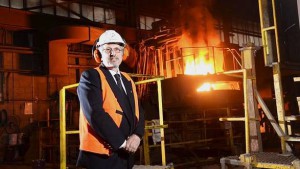
Keech Australia chief executive Herbert Hermens. Photo: Jim Aldersey.
The foundry Keech Australia invested on 3D printing and is now reaping the rewards. Keech Australia chief executive Herbert Hermens says the company’s revenue, now about $50 million, has grown about 10 per cent per year for the past three or four years.
Meanwhile, the broader iron and steel casting industry has shrunk by 0.8 per cent per year from 2010 to 2015, according to IBISWorld, and the decline is forecast to continue.
When Hermens joined Keech five years ago, the company already differed from many foundries because it had its own product line rather than simply manufacturing to order. Keech at the time sold a line of ground-engaging tools – the teeth on the edge of the bucket on mining and construction equipment – and Hermens decided to expand on this.
Hermens started looking at the feasibility of 3D printing because the company could not find enough pattern makers to support a big increase in products.
Keech has since invested a couple of million dollars in 3D printing technology and another million or so in staff and training. The 3D printers used by Keech cost $750,000 each and are depreciated at the same rate as a computer – over four years. The printer is still operational after that time but technologically obsolete, and Hermens says it will be kept it as a back-up and eventually sold on the second-hand market or recycled for parts.
“The problem is you then forego the ability to develop your organisation and your thinking, and that has an enormous value as well,” Hermens says.
Keech now employs eight engineers in its innovation business to develop the software that supports the 3D printer. While the company had to use 457 visas initially to hire the people with the relevant skills, Hermens says engineers have started to approach them now that the company has a reputation in the field.
He also says the investment is paying off financially. The 3D printer allows the creation of prototypes overnight, allowing much faster product development and more tactile demonstration in sales situations. Keech is also using 3D printers to directly produce small runs of specialised equipment, such as the blades of small wind turbines.
When Keech started with 3D printing, the challenge was to stabilise revenue but it quickly tipped into growth, and revenue is now 30-40 per cent higher as a result of new product lines. Keech now exports about 20 per cent of its products, with sales offices in Canada, Chile and South Africa. “It would have been very challenging to go into global markets with the products as they were four years ago,” Hermens says. “The products that we have today are … much more reliable, much more refined, much more adaptive for the various applications. We need to now deal with minus 40 degrees in places like Kazakhstan to plus 40 degrees in the Middle East with the same products. All that testing and design variation has had to go through some iteration that would have taken a long time before 3D printing.”
Keech has a memorandum of understanding with CSIRO, operating as the commercial arm for the government organisation’s 3D printers. CSIRO recently opened Lab22, a $6 million centre for small and medium businesses to try 3D printing and Keech is one of the first partners.
Deloitte’s predictions for 2015 estimate that 200,000 3D printers will be sold worldwide this year, a dollar value of $US2 billion. Although consumers will buy 70 per cent of 3D printers by volume, business purchases will account for 80 per cent by dollar value.
Deloitte also predicts that companies will produce 95 per cent of 3D-printed products and account for 99 per cent of the economic value of 3D-printed products this year. This year nine out of 10 3D-printed objects will be prototypes and only one out of 10 will be final products, but Deloitte expects that ratio will change rapidly.
Source: brw.com.au



